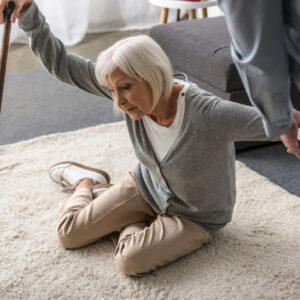Falling Smartly And Safely: Advice On Avoiding Serious Injury

Falling Smartly And Safely: Advice On Avoiding Serious Injury
January 25, 2023
As an older adult, you’re probably aware of the risk of falling and sustaining serious injury. While we can safely say that no one wants to fall, we can also state that the older you get, the more likely you are to fall, and once you’ve fallen, your risk of having another fall goes up considerably. In fact, falling one time doubles your risk of having a repeat fall. Regardless of how careful you think you are, with one false (or accidental) move, your physical life and quality of life can easily be in jeopardy.
For example, should you take a tumble, one serious concern is the risk of hitting your head. While head injuries (leading to potentially serious brain injuries) are often associated with such traumatic events as car crashes, the reality is that a trip and fall in your own home or accidentally whacking your head against a kitchen cabinet can cause serious and even life-threatening brain damage. In fact, it’s estimated that 1.5 million Americans suffer this sort of brain injury each year. Once you’ve hit your head, the implications are far more serious than a broken arm or even hip. In a new study out of the University of Pennsylvania and published in JAMA Neurology researchers report that adults who suffer any head injury have 2x the rate of mortality as compared to those who have not had a head injury. And with more severe head injuries, the risk of mortality is nearly 3x higher. Whether it’s a sports injury or just a slip and fall in your home, that sort of head injury can have serious repercussions for your health and life expectancy. To find out more, click here. So what should you do if you fall and hit your head? Don’t dismiss the accident as minor. Even a small bump can have large implications. Especially for adults on blood thinners, even a minor smack could become life-threatening. Make sure you alert your loved ones and primary care doctor if a fall has caused you to hit your head, and be on the lookout for such worrying symptoms as dizziness, vision impairment, vomiting or headaches. To find out more, grab your helmet and read here.
Another new study reports on risk factors that cause older adults to be at elevated risk of falling at home. Older adults aging in place with dementia are at increased risk of institutionalization following a fall and are at higher risk of experiencing a fall at home as compared to older adults who do not have dementia. In fact, there is data showing that in 2016, nearly half of all community-dwelling adults with dementia had a fall, while only ⅓ of non-demented older adults had such an accident. What creates risk? For those with dementia, such factors as a previous fall or vision impairment put them at elevated risk of another fall. For those without dementia, the risk of falling can come from such factors as home disrepair, a history or fear of falling, and poor lower extremity strength and abilities. No matter the source, and regardless of whether you or a loved one has dementia, it’s critical to lessen or eliminate as many of these risk factors as possible.
And if you find yourself on the floor after a fall? A new post from AARP recommends you actually practice getting up from a fall before it happens. As one expert states, “Being able to get up from the floor (without assistance) is a positive health behavior just the same way as exercising is.” With a video demonstrating technique and areas of concern, this post underscores that once you’ve fallen, any movement that causes pain means you’re best staying on the floor and calling for help, lest you cause further damage (and there is also the risk that caregivers who are present could be injured trying to help you up). For more helpful techniques on raising yourself up, click here.
As for your recovery, Consumer Reports states that ⅕ of all falls cause significant injuries, even if not immediately apparent. Even minor injuries can have long-lasting, permanent effects (not to mention putting you at risk for future falls) if you don’t work with a physical therapist to address the injury and strengthen yourself against future falls. While the recovery process can be slow, “Those who don’t build their activity levels back up are more likely to fall again and more likely to experience a more serious injury the next time around.” It’s a vicious cycle you want to avoid however you can. So remember, any fall can be life-altering. Best to eliminate risk, build strength and improve balance as best as you can. For some useful advice on all those fronts, steady yourself and click here.







